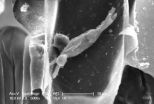(Press-News.org) CORVALLIS, Ore. -- Scientists have long been concerned that global warming may push Earth's climate system across a "tipping point," where rapid melting of ice and further warming may become irreversible -- a hotly debated scenario with an unclear picture of what this point of no return may look like.
A newly published study by researchers at Oregon State University probed the geologic past to understand mechanisms of abrupt climate change. The study pinpoints the emergence of synchronized climate variability in the North Pacific Ocean and the North Atlantic Ocean a few hundred years before the rapid warming that took place at the end of the last ice age about 15,000 years ago.
The study suggests that the combined warming of the two oceans may have provided the tipping point for abrupt warming and rapid melting of the northern ice sheets.
Results of the study, which was funded by the National Science Foundation, appear this week in Science.
This new discovery by OSU researchers resulted from an exhaustive 10-year examination of marine sediment cores recovered off southeast Alaska where geologic records of climate change provide an unusually detailed history of changing temperatures on a scale of decades to centuries over many thousands of years.
"Synchronization of two major ocean systems can amplify the transport of heat toward the polar regions and cause larger fluctuations in northern hemisphere climate," said Summer Praetorius, a doctoral student in marine geology at Oregon State and lead author on the Science paper. "This is consistent with theoretical predictions of what happens when Earth's climate reaches a tipping point."
"That doesn't necessarily mean that the same thing will happen in the future," she pointed out, "but we cannot rule out that possibility."
The study found that synchronization of the two regional systems began as climate was gradually warming. After synchronization, the researchers detected wild variability that amplified the changes and accelerated into an abrupt warming event of several degrees within a few decades.
"As the systems become synchronized, they organized and reinforced each other, eventually running away like screeching feedback from a microphone," said Alan Mix, a professor in OSU's College of Earth, Ocean, and Atmospheric Sciences and co-author on the paper. "Suddenly you had the combined effects of two major oceans forcing the climate instead of one at a time."
"The example that we uncovered is a cause for concern because many people assume that climate change will be gradual and predictable," Mix added. "But the study shows that there can be vast climate swings over a period of decades to centuries. If such a thing happened in the future, it could challenges society's ability to cope."
What made this study unusual is that the researchers had such a detailed look at the geologic record. While modern climate observations can be made every day, the length of instrumental records is relatively short – typically less than a century. In contrast, paleoclimatic records extend far into the past and give good context for modern changes, the researchers say. However, the resolution of most paleo records is low, limited to looking at changes that occur over thousands of years.
In this study, the researchers examined sediment cores taken from the Gulf of Alaska in 2004 during an expedition led by Mix. The mountains in the region are eroding so fast that sedimentation rates are "phenomenal," he said. "Essentially, this rapid sedimentation provides a 'climate tape recorder' at extremely high fidelity."
Praetorius then led an effort to look at past temperatures by slicing the sediment into decade-long chunks spanning more than 8,000 years – a laborious process that took years to complete. She measured ratios of oxygen isotopes trapped in fossil shells of marine plankton called foraminifera. The isotopes record the temperature and salinity of the water where the plankton lived.
When the foraminifera died, their shells sank to the sea floor and were preserved in the sediments that eventually were recovered by Mix's coring team.
The researchers then compared their findings with data from the North Greenland Ice Core Project to see if the two distinct high-latitude climate systems were in any way related.
Most of the time, the two regions vary independently, but about 15,500 years ago, temperature changes started to line up and then both regions warmed abruptly by about five degrees (C) within just a few decades. Praetorius noted that much warmer ocean waters likely would have a profound effect on northern-hemisphere climates by melting sea ice, warming the atmosphere and destabilizing ice sheets over Canada and Europe.
A tipping point for climate change "may be crossed in an instant," Mix noted, "but the actual response of the Earth's system may play out over centuries or even thousands of years during a period of dynamic adjustment."
"Understanding those dynamics requires that we look at examples from the past," Mix said. "If we really do cross such a boundary in the future, we should probably take a long-term perspective and realize that change will become the new normal. It may be a wild ride."
Added Praetorius: "Our study does suggest that the synchronization of the two major ocean systems is a potential early warning system to begin looking for the tipping point."
INFORMATION:
Synchronization of North Atlantic, North Pacific preceded abrupt warming, end of ice age
2014-07-25
ELSE PRESS RELEASES FROM THIS DATE:
A world first: Researchers identify a treatment that prevents tumor metastasis
2014-07-25
Metastasis, the strategy adopted by tumor cells to transform into an aggressive form of cancer, are often associated with a gloomy prognosis. Managing to block the metastasis or, even better, prevent their formation would be a giant step towards the fight against cancer. Researchers at Université catholique de Louvain (Belgium) successfully performed this world first on models of human tumors in mice. The results of their study are published online on 24 July in the prestigious journal Cell Reports.
The work by Professor Pierre Sonveaux's team, at Université catholique ...
Noise pollution impacts fish species differently
2014-07-25
Acoustic disturbance has different effects on different species of fish, according to a new study from the Universities of Bristol and Exeter which tested fish anti-predator behaviour.
Three-spined sticklebacks responded sooner to a flying seagull predator model when exposed to additional noise, whereas no effects were observed in European minnows.
Lead author Dr Irene Voellmy of Bristol's School of Biological Sciences said: "Noise levels in many aquatic environments have increased substantially during the last few decades, often due to increased shipping traffic. ...
Four-billion-year-old chemistry in cells today
2014-07-25
Parts of the primordial soup in which life arose have been maintained in our cells today according to scientists at the University of East Anglia.
Research published today in the Journal of Biological Chemistry reveals how cells in plants, yeast and very likely also in animals still perform ancient reactions thought to have been responsible for the origin of life – some four billion years ago.
The primordial soup theory suggests that life began in a pond or ocean as a result of the combination of metals, gases from the atmosphere and some form of energy, such as a lightning ...
Corn and soy insecticides similar to nicotine found widespread in Midwest rivers -- USGS news
2014-07-25
Insecticides similar to nicotine, known as neonicotinoids, were found commonly in streams throughout the Midwest, according to a new USGS study. This is the first broad-scale investigation of neonicotinoid insecticides in the Midwestern United States and one of the first conducted within the United States.
Effective in killing a broad range of insect pests, use of neonicotinoid insecticides has dramatically increased over the last decade across the United States, particularly in the Midwest. The use of clothianidin, one of the chemicals studied, on corn in Iowa alone ...
Zerenex (ferric citrate) long-term Phase 3 study results published in JASN
2014-07-25
New York, NY - July 24, 2014 -- Keryx Biopharmaceuticals, Inc. (Nasdaq:KERX) (the "Company") announced the publication of results from the long-term, randomized, active control Phase 3 study of Zerenex (ferric citrate), the Company's investigational oral ferric iron-based phosphate binder, for the treatment of hyperphosphatemia in patients with end-stage renal disease (ESRD) on dialysis. The PERFECTED study (PhosphatE binding and iRon delivery with FErric CiTrate in EsrD) was published online today in the Journal of the American Society of Nephrology (JASN).
This Phase ...
New hope for powdery mildew resistant barley
2014-07-25
New research at the University of Adelaide has opened the way for the development of new lines of barley with resistance to powdery mildew.
In Australia, annual barley production is second only to wheat with 7-8 million tonnes a year. Powdery mildew is one of the most important diseases of barley.
Senior Research Scientist Dr Alan Little and team have discovered the composition of special growths on the cell walls of barley plants that block the penetration of the fungus into the leaf.
The research, by the ARC Centre of Excellence in Plant Cell Walls in the University's ...
NRG1 isoforms could be an effective therapeutic candidate to promote peripheral nerve regeneration
2014-07-25
Neuregulin 1 (NRG1) is a pleiotropic factor characterized by the existence of numerous isoforms arising from alternative splicing of exons that confer to the protein deeply different characteristics. NRG1 plays an important role for both the myelination occurring during development and the different phases occurring after injury in the peripheral nerve: axon degeneration, axon regrowth, remyelination and target reinnervation
Researchers at the University of Western Australia have discovered that the soluble NRG1 upregulation observed in Schwann cells immediately after ...
Assessment on self-care ability of children with spina bifda
2014-07-25
Spina bifda (SB) is a complex congenital central nervous system disease that is caused by the incomplete closing of the neural tubes during the embryonic phase. Many patients have varying degrees of spasticity, urinary and fecal incontinence and neurocognitive retardation. Such problems decrease the patients' functional independence and their quality of life. Researchers at Ankara Physical Medicine and Rehabilitation Education and Research Hospital, Turkey investigate the functional performance in children with SB, using the Pediatric Evaluation of Disability Inventory ...
Neurologic recovery from corticospinal tract injury due to subfalcine herniation
2014-07-25
After development of diffusion tensor tractography (DTT), which is derived from diffusion tensor imaging (DTI), three-dimensional reconstruction and estimation for three motor tracts, such as the corticospinal tract, the rubrospinal tract, and the corticoreticular pathway became possible. The corticospinal tract is known to be a major neural tract for motor function in the human brain. Several studies have reported on injury of the corticospinal tract by transtentorial herniation. In addition, some studies have demonstrated recovery of a corticospinal tract injured by transtentorial ...
Bacteria manipulate salt to build shelters to hibernate
2014-07-25
For the first time, Spanish researchers have detected an unknown interaction between microorganisms and salt. When Escherichia coli cells are introduced into a droplet of salt water and is left to dry, bacteria manipulate the sodium chloride crystallisation to create biomineralogical biosaline 3D morphologically complex formations, where they hibernate. Afterwards, simply by rehydrating the material, bacteria are revived. The discovery was made by chance with a home microscope, but it made the cover of the Astrobiology journal and may help to find signs of life on other ...



